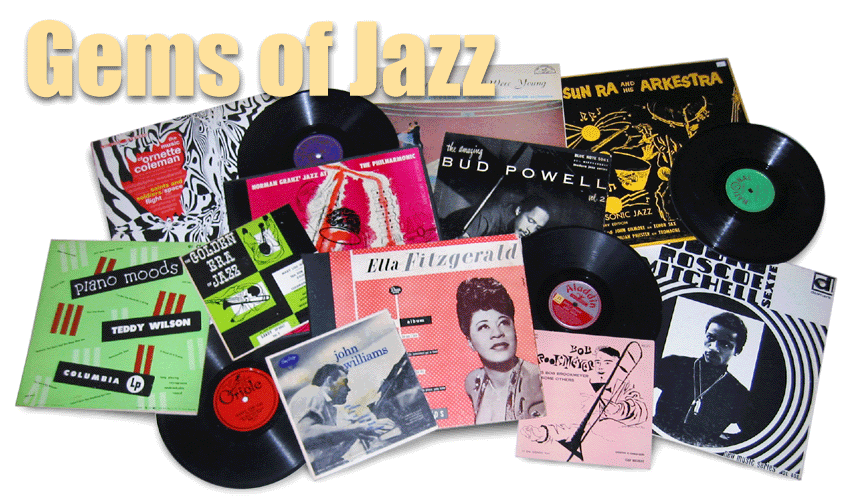 |
| I can't remember why I made this sketch – possibly it was for a display for the record store I worked in back in college. Whatever the reason, happy birthday, Yard! |
August 27th and 29th are cardinal days in jazz culture, being the respective birthdays of Lester Young and Charlie Parker. I always do a special on my radio show for them, and I thought I'd mark the dates by posting an offering here at Gems as well.
Nothing need be said here about these two seminal figures – if you're into jazz, you already know the backstory. The President was the progenitor of a entirely divergent school of thought about the tenor saxophone and the Bird took flight on those ideas and made improvisation into an art music. 'Nuff said.
 |
| Lester as one of Walter Page's Blue Devils in 1932. With him are Doc Ross, left, and Buster Smith, right, the band's other reed players. Pres does indeed look devilish with whatever that is behind him. |
These two LPs came into my possession when I was working in Boston at that Discount Records warehouse I mentioned many posts ago. The assistant manager of the company's Northeast region had offices there and I would see him occasionally on the phone behind his desk as I humped record cartons from the freight elevator to the delivery truck. He was about my age and was something of a party animal with high-waist bell bottoms, platform shoes, fitted nylon shirts and a severely teased mullet. He had a penchant for all-night revels, usually with a few of the hipper store managers in tow, and after one particularly wild weekend he never returned. The story went around that he'd burned too many bridges and had been asked to seek his fortune elsewhere. We heard he'd gone to L.A.
A few days after his departure, several skids of boxes were delivered to the warehouse. These turned out to be the former assistant manager's personal effects. The cartons contained clothes, shoes, toiletries, papers, nick-knacks and the like, and we were supposed repack them and ship them out to him when the word came down. I noted that along with all the personal stuff were a half dozen boxes of records. These intrigued me, because they were almost all rare and unusual imported jazz LPs. The manager, I knew, cared nothing for jazz and wouldn't have known John Coltrane from Chi Coltrane. How had these come into his possession?
Word never did come down on where to ship the boxes. The assistant manager's effects sat a the corner of the warehouse for months. My boss eventually tired of moving the cartons and got rid of them. But before he did, we were allowed to pick through the lot. I, of course, went for the records, and these two Queen Discs were among those I took.
The music contained in these records is probably available today on CD in one form or another, but back in the '70s these performances were ultra-rare. And they are, almost without exception, truly inspired.
The accepted take on Lester's playing following his devastating US Army stint is that it is inferior. His performances here disprove that canard. "Jumpin' with Symphony Sid" stands with the best of Pres, and "Lester Leaps In" is outstanding. Plus, you get to hear Lester introduce the tunes.
The Bird LP captures Charlie in several unusual settings – including a version of "Groovin' High" with Lionel Hampton's keyboardist, Milt Buckner, playing organ. "Dance of the Infidels" finds Bird playing with the Massey Hall line-up minus Diz, probably right around the same time as the famed Toronto concert. It's astonishing for its intensity. And on the Bandbox aircheck, Bird corrects a confused Leonard Feather on tune titles.
So, happy birthday to Bird and Pres! Celebrate by enjoying these fine examples of their magnificent artistry. The files were, as always, ripped from the original vinyl with only a slight cleaning of sound.
By the way – how did the assistant manager come by these and the other remarkable jazz sides in his pile? I found out many years later that his father was one of the West Coast's leading rare jazz LP dealers. If you've been in the collecting game for a while, you've probably been a recipient of one of his record auction lists in the not-too-distant past ...

Charlie Parker
Charlie Parker
Parker, as; various groups, locations, dates (see cover for listings).
Queen Disc 002
1. Anthropology
2. Cool Blues
3. Your Father's Moustache
4. Groovin' High
5. Star Eyes
6. Ornithology/How High the Moon
7. Diggin' Diz
8. Embracable You
9. Moose the Mooche
10. Cheryl
11. Dance of the Infidels

Lester Young
Lester Young
Lester Young, ts: various groups, locations, dates (see cover for listings).
Queen Disc 001
1. Pennies from Heaven
2. Polka Dots and Moonbeams
3. Jumpin' with Symphony Sid
4. These Foolish Things
5. Three Little Words
6. Lester Leaps In
7. A Ghost of a Chance
8. Just You, Just Me
9. Sweet Georgia Brown
Find it here: http://www.mediafire.com/?rqeqjyy59ld7brc















